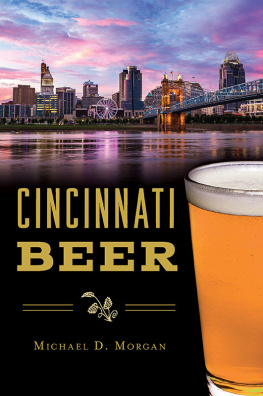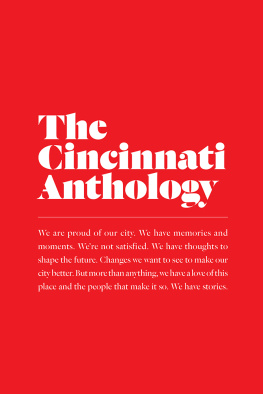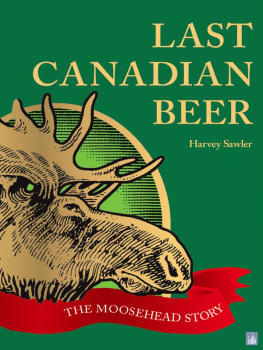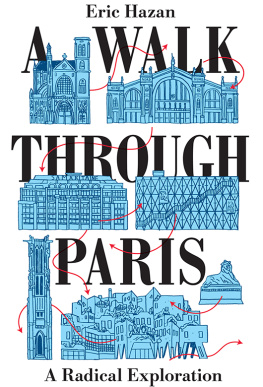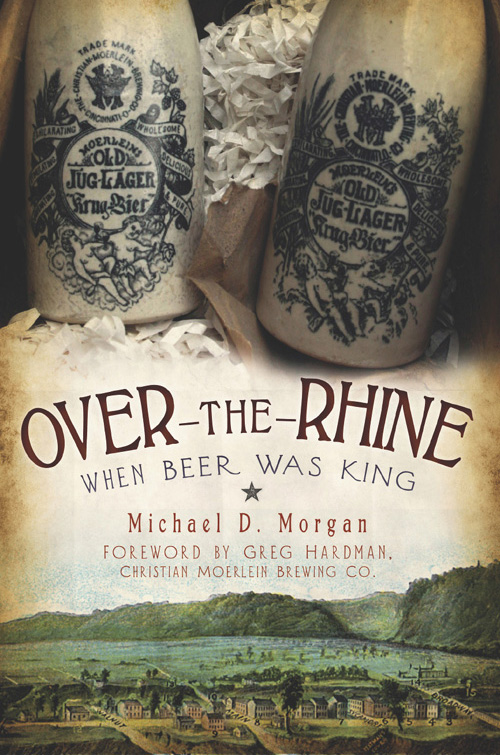


Published by The History Press
Charleston, SC 29403
www.historypress.net
Copyright 2010 by Michael D. Morgan
All rights reserved
Unless otherwise noted, all images are from the authors collection.
First published 2010
Second printing 2011
e-book edition 2011
ISBN 978.1.61423.198.1
Library of Congress Cataloging-in-Publication Data
Morgan, Michael D.
Over-the-Rhine : when beer was king / Michael D. Morgan.
p. cm.
Includes bibliographical references.
print edition ISBN 978-1-59629-914-6
1. Over-the-Rhine (Cincinnati, Ohio)--History. 2. Cincinnati (Ohio)--History. 3. Over-the-Rhine (Cincinnati, Ohio)--Social conditions. 4. Cincinnati (Ohio)--Social conditions. 5. Beer--Ohio--Cincinnati--History. 6. Breweries--Ohio--Cincinnati--History. 7. Drinking of alcoholic beverages--Ohio--Cincinnati--History. 8. German Americans--Ohio--Cincinnati--History. 9. Over-the-Rhine (Cincinnati, Ohio)--Ethnic relations. 10. Cincinnati (Ohio)--Ethnic relations. I. Title.
F499.C56O846 2010
977.178--dc22
2010030905
Notice: The information in this book is true and complete to the best of our knowledge. It is offered without guarantee on the part of the author or The History Press. The author and The History Press disclaim all liability in connection with the use of this book.
All rights reserved. No part of this book may be reproduced or transmitted in any form whatsoever without prior written permission from the publisher except in the case of brief quotations embodied in critical articles and reviews.
For Amy. Thank you for your help, patience, support and love through this book and all of the Over-the-Rhine years.
CONTENTS
FOREWORD
My history with Cincinnati beer started as a young beer representative for a distributor that serviced the Athens, Ohio market. While I was working for that distributor and selling Cincinnati beer, I just happened to be in the city to watch one of the last days of production at the old Hudepohl brewery on Gest Street. I watched those bottles roll off the line and I saw the faces of the people around me, and the sense of loss was heartbreaking. Even though I wasnt from here, I understood what they were feeling. Beer is a huge part of the citys history. When Cincinnati lost local ownership of its brands, I felt like it was losing a big part of its soul as a city, and I bought the Christian Moerlein, Hudepohl, Burger, Schoenling, Little Kings and over sixty other local brands both to build a business and to try to do the right thing for Cincinnatito bring back its brewing heritage.
After I met Mike Morgan during Bockfest 2006 and learned more about the history of the Brewery District in Over-the-Rhine, I started to get increasingly interested in the neighborhood because most of the brands I now own came from there. I already planned on bringing the Cincinnati brewing heritage back to town, but as I learned more about the history of Over-the-Rhine and started getting involved in its revitalization, I knew that there was one place above all others where Moerlein and Hudepohl should be brewed. It had to be their original homeOver-the-Rhine. A lot of very smart, suburban advisers tried to steer me in other directions, but I knew that I wanted to be part of the neighborhoods future. I wanted to authentically restore Over-the-Rhines brewing heritage.
My commitment to Over-the-Rhine started by learning about its history. Thats what brings it alive. Thats what makes you understand what is so important about saving and rebuilding it. In the time that I have been involved in Over-the-Rhine, I have seen very few people who are as committed to the neighborhood, as knowledgeable about its history or as passionate about sharing it as Mike Morgan. He has been essential in both inspiring me and helping me bring Cincinnatis brewing heritage back to the city, and Im glad that he has made his contribution to telling this early history of Over-the-Rhine.
Greg Hardman
President and CEO
Christian Moerlein Brewing Co.
ACKNOWLEDGEMENTS
In late 2005, I found myself in the usual position at the bar at Arnolds Bar & Grill, but I also found myself in the extremely unusual position of agreeing to organize a parade for an event called Bockfest. This began a very long journey into the rich history of Over-the-Rhine and led to a compulsion to save it from destruction. Part of this work has included sharing the neighborhoods story with others, because the first step in preventing Over-the-Rhine from physical destruction is to help people understand why it is worth saving. It is valuable from a purely architectural standpoint, but it is more than that. It is a living and endangered piece of American history. As I shared Over-the-Rhines story through tours and public presentations, I became cognizant of the questions that I couldnt answer because I couldnt find those answers in any of the numerous publications about either Over-the-Rhine or Cincinnatis brewing history. This is not a book about brewing history. That has already been done. It also does not claim to be a complete history of Over-the-Rhine or even an exhaustive chronicle of its earliest years. This is a book about the early history of Over-the-Rhine that attempts to answer the questions that I could not previously answer about the role of beer, brewing and German ethnicity in the rise and fall of Over-the-Rhine.
I owe a debt of gratitude to Steven Hampton, president of the Brewery District CURC, both for his assistance with this publication as well as all that he does for Over-the-Rhine; and to Greg Hardman, president and CEO of Christian Moerlein Brewing Company and the caretaker and redeemer of Cincinnatis brewing heritage. While I have known both of these men for only a few years, they have been Over-the-Rhine years, which are much longer than standard human years and require good, trusted friends to survive with sanity.
Thanks to Chris Smith, Diane Mallstrom, David Siders and many other members of the exceptional staff in the Public Library of Cincinnati.
I am also grateful to Linda Bailey of the Cincinnati Museum Center and Kevin Grace of the University of Cincinnati for their assistance with historic photographs.
Most of all, thanks to my wife, Amy, for all of her assistance. I could not have completed this project without her.
HOW TO FIND A BUILDING UNDER YOUR BUILDING
On a mid-November morning in 2009, an architect, two lawyers and the president of a beer company stood on a section of McMicken Avenue sidewalk arguing about the dates and order of events that led to the repeal of Prohibition. Over the past few decades, the streets of Cincinnatis Over-the-Rhine have gained a reputation for a number of activities. Spontaneous academic debate is not one of them, but this group of amateur local historians was waiting to see what a couple of amateur urban archaeologists were going to find underneath the sidewalk in front of them.
The backhoe was two hours late, but eventually the large diesel truck pulled up, dropped its loading ramps and started backing a large piece of excavation equipment onto McMicken. Dump truck and backhoe assumed their positions, hurricane fencing was wrapped around a tree and some poles to block off sidewalk traffic, the small group of onlookers stopped arguing and assumed a safe distance and the dump bucket made a multiton tap onto the sidewalks concrete surface. Roughly ten minutes later, the backhoe firmly snagged its claws on a sheet of broken concrete, lifting one edge a couple feet from the surface. Everything stopped. The operator climbed down from the equipment. The onlookers moved forward. The mystery of what lay underneath was about to be revealed.


